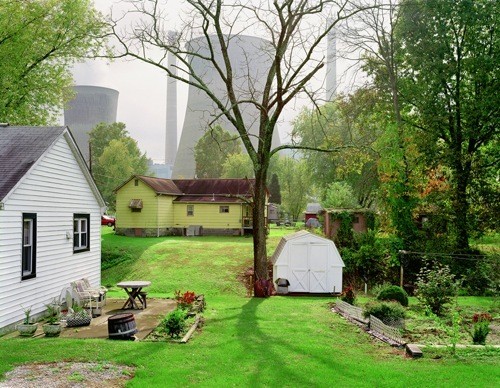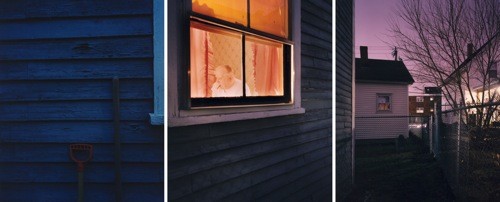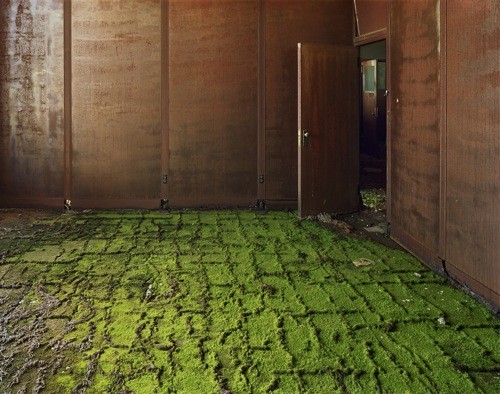Industry and government have long altered the landscape as if they were producing land art’s evil twin, creating exquisite scars that are the visual evidence of our need for power. Some of the most compelling photographs in PEOPLE PLACES POWER: Reframing the American Landscape, on view at the Davidson College Art Galleries through February 25, document this phenomenon.
The subject matter of these photographs gives them their moral authority. But it is the cruel, unearned beauty of the forms depicted — a gash of city light in the desert night, the elegant curve of a cooling tower, a single fence at the border — that draws us in, enmeshing us in a queasy, guilt-ridden relationship.

- Mitch Epstein, "Amos Coal Power Plant, Raymond, West Virginia," 2004, (Image courtesy the artist and Sikkema Jenkins & Co., New York)
The exhibition’s dominant image — it’s not only the centerpiece of the publicity, but it quietly assaults you as you first enter the galleries — is Mitch Epstein’s "Amos Coal Power Plant, Raymond, West Virginia." In this subdued display of twisted normalcy, cooling towers loom behind a modest, pleasant neighborhood with a mix of paternalism and threat. The gray towers almost blend in with the sky, giving the whole image a weird sense of intimacy and rightness.

- David Hilliard, "Dad," 1998, (Image courtesy the artist and Yancey Richardson Gallery, New York)
Some images seem to depict a struggle in which nature is victorious. Andrew Moore’s "Model T HQ, Detroit" shows a ruined interior with what at first glance appears to be the remains of a filthy green carpet — but is in reality a moss-covered floor. Victoria Sambunaris’ "Wendover, Utah" portrays a dreary, isolated development that stands in sad contrast to the pristine mountains in the distance.

- Andrew Moore, "Model T HQ," Detroit, 2009, (Image courtesy the artist and Yancey Richardson Gallery, New York)
I’m a total sucker for images of the majestic, exploited landscape, so it's probably due to personal taste that my energy started to flag in the final gallery, with its emphasis on people and personal drama. This is not to disparage the many noteworthy photographs in this space, among them David Hilliard’s poignant "Dad," a pensive, perhaps defeated figure viewed through the window of his house, as well as "Tracy (Cherry Drizzle)" by art star Ryan McGinley. There is simply an abundance of work in this exhibition that demands serious consideration, and even with a spare installation that allows each piece to speak for itself, there is almost too much to view. This show is a must-see; just make sure you allot plenty of time.
While doing the preliminary research for PEOPLE PLACES POWER, gallery director Brad Thomas (who gets high marks for the restrained, intelligent curating of this exhibition and pretty much anything else that crosses his path) learned that Mitch Epstein and author Susan Bell were collaborating on WHATISAMERICANPOWER.COM, a public art project involving a website and billboards in Cincinnati and Columbus, Ohio. Epstein and Bell agreed to extend the project to include a poster campaign in Davidson and the Charlotte area. To participate in Poster – Picture – Post: A Community Collaboration, pick up a free poster at the gallery before February 25, mount it (with permission) in a public space, then document it and post your image on the gallery’s Facebook page.
— Barbara Schreiber
